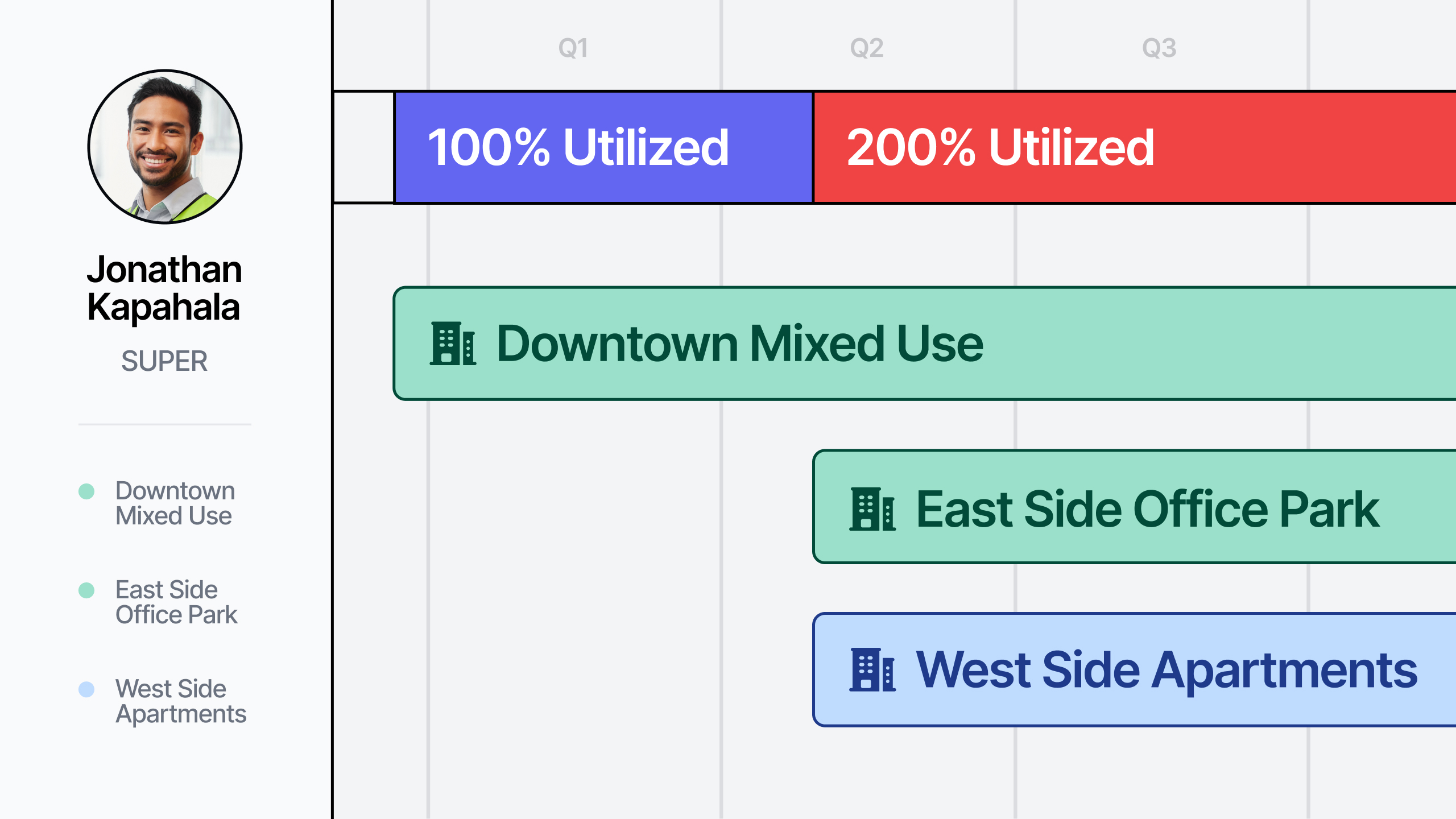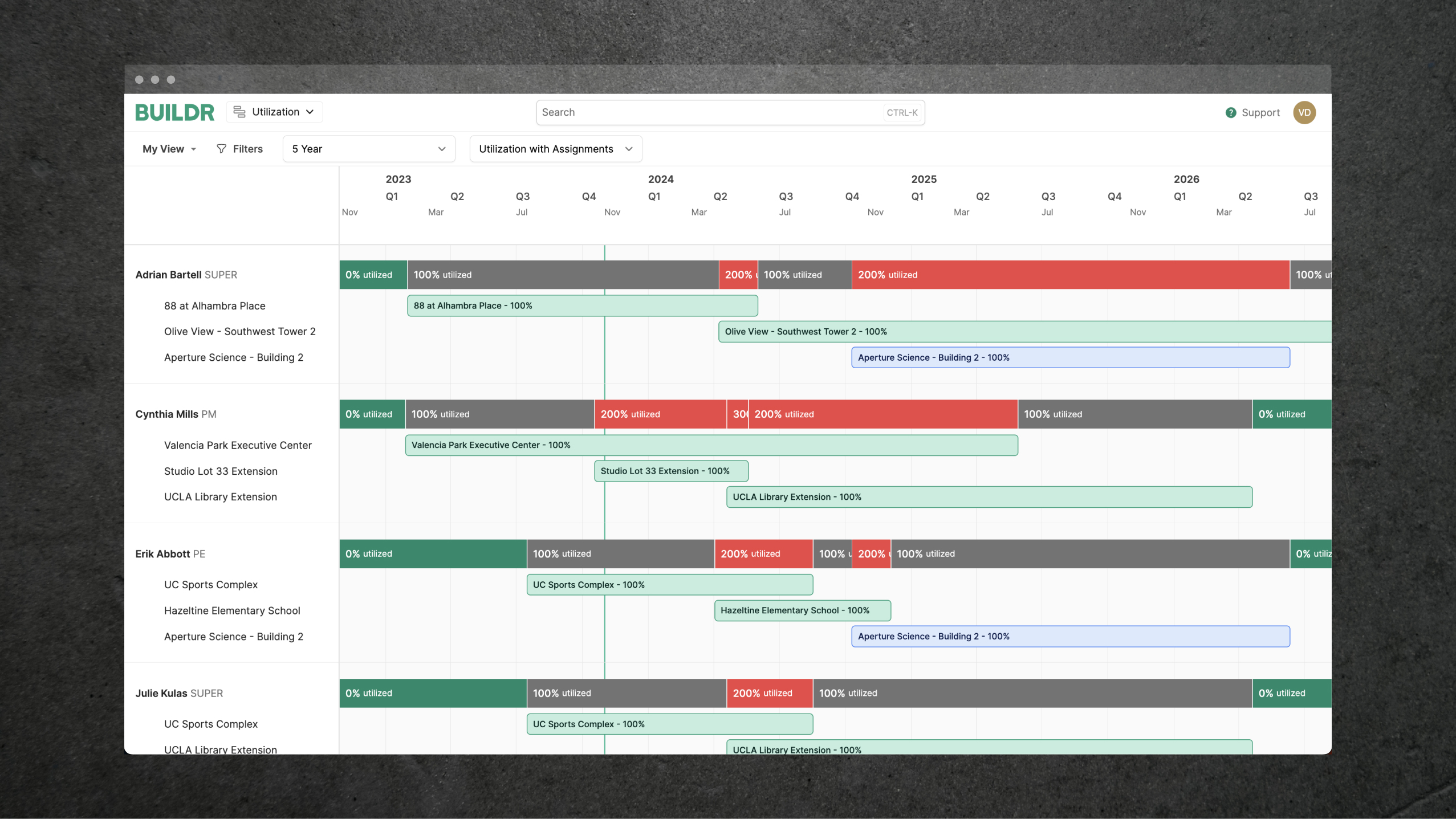
Workforce Utilization 101: The key to longevity for general contractors
Workforce utilization is tracked in most industries, but less so in construction where it's especially important
November 1, 2023
8 min read
Learnables

Edward Gonzalez
Founder at Buildr

Workforce utilization is a metric that is necessary to track in any industry where analyzing how and where labor’s time is spent matters to the company facilitating that labor.
There’s no industry on earth where workforce utilization matters more than in construction. This is because:
Cost of labor accounts for such a sizable chunk of a project’s budget; 20%-50% depending on the project,
Not all labor costs the same; your most experienced and skilled team members are going to cost you a prettier penny,
Throttled supply chain and elevated input prices,
Constant ebb and flow of project priority (ie., office buildings slowing in post-remote boom),
More competing general contractors than ever in every market, and
There’s a skilled labor shortage with no end in sight (see also: Gen Z doesn’t see the appeal of working in construction).
In a nutshell, workforce utilization is important to general contractors because labor is expensive (and only getting more-so), GC profit pools are continuously shrinking (due in part to the looming, or current existence of, a global recession), and there aren’t enough workers, indefinitely.
What utilization affects in construction
1. Profitability
With utilization mismanagement, hits to your profit pool could occur from a few different angles—
Paying people to sit on the bench
General contractors that don't keep a keen eye on their utilization rate all have one thing in common: they're leaving money on the table by paying team members to do absolutely nothing. This negligence becomes more common when the operations department is staffing multiple ongoing projects and lose sight of the big picture.
It's worth noting that true negligence, ie., "Oh wow, Randall Jones isn't even on a job right now and hasn't been all year?!" is less likely than a much more common and frustrating scenario:
Operations knows full-well that Randall Jones is sitting in the office playing online chess but they need to keep paying him because a communication gap between business development and operations a year ago created a disproportionate personnel-to-project ratio. Of course, this hypothetical GC probably can't afford to let Randall go because the labor shortage removes the guarantee they could sufficiently replace him down the road.
If a general contractor's workforce is underutilized, the fixed costs associated with each employee are spread over fewer billable hours. Salaries, benefits, insurance, training—all of these costs amount to significantly less profit when it's given to team members with a lull in their schedule. Profit hits from underutilization mean you're essentially paying your employees to wait around for you to become more competent at your job. Yikes.
To learn more about bridging the gap between business development and operations so mismanagement scenarios like this can no longer eat away at your profit pool, be sure to check out our blog on consolidating your workforce planning and CRM processes.
Hiring costs
If you overutilize members of your workforce, you could burn those individuals out and they could search for greener, more utilized pastures at other GCs. With the skilled labor shortage, this is an even bigger snafu because now you need to devote resources and money to finding suitable replacements.
Project stoppages and extensions
Workforce mismanagement and safety concerns could lead to project stoppages. This is never a good luck because you're burning the candle at both ends—your reputation with your client takes a hit, as does your profit on the job in question.
Continued employment costs are the obvious hit. Another cost is for idle equipment in cases where equipment is rented or leased based on project requirements. Otherwise, if projects are delayed or extended it could cause postponement of payment. This could lead to the GC relying more on financing options, which come with interest and other associated costs.
In the end, if you’re not analyzing your utilization for the sake of optimizing it, you’re almost guaranteed to be severely limiting how much profit your firm takes home on a job. We say “almost” just in case there’s one workforce planning savant out there that can Beautiful Mind their way to perfect utilization across every job, all in their head.

2. Safety
If you’re overutilizing members of your team, errors are more prone to occur. The folks most at risk are the ones doing the actual labor on the job site—they’re all relying on the administrative competence above them. With extended hours and the rush to meet deadlines, workers may not be as vigilant about following safety protocols, wearing the appropriate safety gear, or ensuring that equipment is used exactly how it should be.
The most obvious safety risk around overutilization is strain and fatigue. Humans only have so much in the tank each day. Pushing them beyond their capacity could lead to fatigue, decreased motor skills, accidents, and injuries.
3. Execution
If you’re not optimizing for utilization, your ability to execute on a project—both timeline and quality—could suffer. If you check out any old general contractor's website, you can bet they claim they’re doing their best. Only when they track utilization and hover organizationally around 100%, can they make such a claim from an objective standpoint.
Quality of work doesn't equate to quantity of work in construction. If one team member works a 13 hour day on two separate jobs, that doesn't necessarily mean they did better than someone who worked 8 hours on one job. It's possible but not likely.
Increased mental stress can occur when workers have to juggle more tasks, multiple projects, or handle their responsibilities at an accelerated pace. Increased mental stress can lead to oversights and miscommunication, which directly affects the execution of projects.

Poor execution on jobs doesn't just mean the project didn't turn out as great as you would've hoped. It means your reputation takes a hit, which has dire consequences for the longterm success of your business.
It should go without saying that manually keeping track of workforce utilization gets very difficult when a general contractor is building multiple projects at the same time while planning their staffs of the multiple more they’re planning to build. Considering this is how most GCs do business, it’s a wonder then that software-aided workforce planning, let alone workforce utilization, has only just started picking up steam in the last 3-5 years.
The inherent problems underneath traditional methods of workforce management
Many general contractors consider themselves small enough that they can still use spreadsheets to manually assign their workforces.
The GCs that think more outside-of-the-box and realize spreadsheets are too limited in collaboration and visibility will advance to splattering workforce assignments across the white-boarded walls of their office. We’ve heard everything from a big ol' chalkboard, to posterboards, to different colored construction paper (that’s on brand, at least) representing different staffed roles.
The most vital metric that isn't being tracked in any of these scenarios is, you guessed it, workforce utilization.
Sure, every slot is filled that needs to be on all your concurrent jobs. But what’s your most skilled workers’ utilization rate? Are you burning anyone out? Are you underutilizing anyone and throwing away profit? Are you compromising the safety of job sites by overutilizing too many people on the same project?
Of course, these questions are tough to answer objectively without using software built to track and analyze utilization rates. You could, in theory, go through and manually figure out the percentage of each individual team member’s time spent on projects against how much time they’re being paid for. But when you’re juggling this process for everyone at once, and it’s constantly changing as you optimize workforces for every tentative job, you can imagine how complicated it can get.
To read more about how to properly calculate your workforce utilization rate, be sure to check out our blog—the aptly titled How to calculate workforce utilization rate.
Buildr helps GCs boost profitability through utilization analysis
Stay in the loop
Seriously, you should sign up to be a construction insider. Everyone will be so jealous of you.